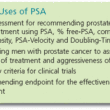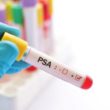Enhancements of PSA Tests to Increase Specificity

Because PSA screening has false positives, enhancements have been sought to increase the specificity of PSA testing. PSA Velocity (PSAV) correlates with both prostate cancer risk and aggressiveness. PSAV Risk Count quantifies the persistence of PSA increases over time, i.e., the number of times the PSAV increases by a specific amount, such as 0.2 or 0.4 ng/mL/year. PSA Density (PSAD) (PSA a specific amount, such as 0.2 or 0.4 ng/mL/year. PSA Density (PSAD) (PSA ÷ prostate volume) measurements factor in the prostate size in relation to the serum PSA level, because a man with an enlarged prostate would be expected to have higher PSA. A PSAD >0.10-0.15 ng/mL/cc indicates a high risk of prostate cancer.
Age-Specific Median PSA Values help guide whether an individual’s PSA value is high by comparing it to levels in his peer age group. Baseline PSA levels in men in their 40s and 50s are potent predictors of the risk for prostate cancer metastases and prostate cancer deathdecades later — even a more powerful predictor than family history or African ancestry. The median PSA for men in their 30s, 40s, 50s, 60s, 70s, and 80s is approximately 0.5, 0.7, 0.9, 1.3, 1.7, and 2.1 ng/mL, respectively. The risk for aggressive prostate cancer is increased in men with PSA levels above the median for their age group, with more than half of prostate cancer deaths occurring inmen with PSA levels in the highest 25th percentile of their age-specific PSA reference range measured at age 40-55 years.
Free-to-Total PSA (% free PSA) (free PSA ÷ total PSA x 100) correlates with the likelihood of prostate cancer and aggressive disease. If the free-to-total ratio is less than 10%, there is greater than a 50% likelihood that a biopsy would show prostate cancer. In contrast, a ratio greater than 25% is associated with less than a 10% risk of prostate cancer.
Prostate Health Index (phi) (approved by the FDA in 2012) measures total PSA, free PSA, and [-2] proPSA.. These values are used in a mathematical model, phi = [-2]proPSA ÷ freePSA x √total PSA. Intuitively, a higher total and [-2]proPSA with a lower free PSArelative to each other make prostate cancer more likely. The output of the phi test is the probability that a biopsy would show prostate cancer and clinically significant disease.
Dr. Catalona led the pivotal studies that achieved FDA approval of the PSA, free-to-total PSA, and Prostate Health Index (phi) test.
Other Biomarkers and Imaging Studies
MRI and PET scans provide independent information aboutprostate cancer risk, improving the accuracy of PSA testing and increasing the likelihood of preferentially identifying clinically significant disease.
PSA Standardization Bias
Commercial PSA assays are standardized against one of two standards: Hybritech or the World Health Organization (WHO). The WHO standard yields PSA levels 20-30% lower than Hybritech-standardized assays; therefore, PSA results from different assays are not interchangeable.
MJAMA. 1998;279(19):1542-1547
J Urol. 2011;185(5):1650-1655



















